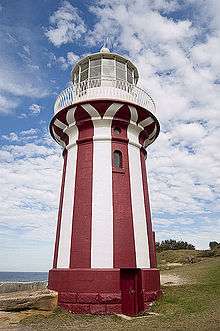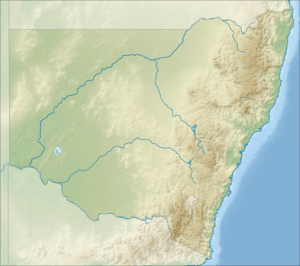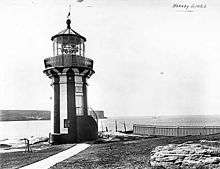Hornby Lighthouse
 Hornby Lighthouse, 2010 | |
 New South Wales | |
| Location |
South Head New South Wales Australia |
|---|---|
| Coordinates | 33°50′0.86″S 151°16′51.61″E / 33.8335722°S 151.2810028°ECoordinates: 33°50′0.86″S 151°16′51.61″E / 33.8335722°S 151.2810028°E |
| Year first constructed | 1 858 |
| Automated | 1933 |
| Construction | sandstone tower |
| Tower shape | cylindrical tower with balcony and lantern |
| Markings / pattern | striped vertically red and white tower, white gallery and lantern |
| Height | 9.1 metres (30 ft) |
| Focal height | 27 metres (90 ft) |
| Original lens | first order catoptric lens |
| Range | 15 nautical miles (28 km; 17 mi)[1] |
| Characteristic | L Fl W 5s. |
| Admiralty number | K2636 |
| NGA number | 111-6180 |
| ARLHS number | AUS-093 |
| Managing agent | Sydney Harbour National Park |
Hornby Lighthouse, also known as South Head Lower Light, is an active lighthouse located on the tip of South Head, New South Wales, Australia, a headland to the north of the suburb Watsons Bay. It marks the southern entrance to Port Jackson and Sydney Harbour,[2] as well as lighting the South Reef, a ledge of submerged rocks.[3] It is the third oldest lighthouse in New South Wales.[4]
History


The need for a lighthouse at the entrance of Jackson Bay was made evident by the loss of two ships. First was the Dunbar, wrecked in August 1857, with the loss of 121 lives. The second was Catherine Adamson, two months later in October 1857, with a loss of twenty-one lives.
A committee of the Light, Pilot and Navigation Board took evidence in September 1857 and recommended the construction of a 30 feet (9.1 m) lighthouse on the inner South Head, showing a fixed white light (F.W.), although a red light was also considered.[5]
The lighthouse was designed by Alexander Dawson, the New South Wales Government Architect at that time. Dawson approved the recommended location as having adequate foundations, and also reported that the government stores already had a catoptric lens apparatus available that has been purchased in 1853.[5]
The tower construction ended in 1858, and it was the third lighthouse built in New South Wales, following Macquarie Lighthouse in 1818 and Nobbys Head Light in 1858.[4] It was opened by Sir William Denison, Governor of New South Wales, and named after the family of his wife Caroline,[3] daughter of Admiral Sir Phipps Hornby,[4][6] though it was known as the "Lower Light", to distinguish it from Macquarie Lighthouse, the "Upper Light".[4]
The original apparatus was a first order catoptric lens, and the light source was a kerosene lamp.[3][4]
Also built with the lighthouse was a sandstone keeper's cottage, also designed by Dawson. A second cottage was constructed in 1860, and two rooms were added to each of the cottages in 1877. The cottages were connected to the city water only in 1897, using stored waters until then.[4]
In 1904 the light was upgraded to incandescent gas,[7] In 1933 the light was electrified, and the lighthouse was automated and demanned.[4][6]
In 1948 a Chance Brothers catadioptric lens was installed, and the light characteristic was changed to a rhythmic light.[4]
Following the automation of the lighthouse in 1933, the lighthouse and cottages fell into disuse. With World War II the shoreline fell under control of the Army, and remained so until 1977, housing serving married personnel. Following classification by the National Trust in 1975, the army transferred the station to the National Parks and Wildlife Service, which restored the cottages and instated caretakers.[4]
The light's current characteristic is a white light showing two seconds on, three seconds off (L.Fl.W. 5s),[8] visible for 15 nautical miles (28 km; 17 mi).[1] The current light source is a 12 volt 55 watt quartz halogen lamp.[4]
Structures
The lighthouse is a tapered circular structure, built of curved dressed sandstone[4] and standing 9.1 metres (30 ft) above the ground.[8] It is painted with distinctive red and white vertical stripes. The sandstone was quarried locally.[4]
On top of the tower is a non-ferrous metal balcony and railing, painted white, surrounded the glass-enclosed lamp.[3][6]

To the west of the tower are the two Georgian style sandstone cottages, now painted, constructed from the same locally queried sandstone, and having timber verandahs and picket fences.[6] The original slate roofing has been replaced with corrugated asbestos.[6]
Site operation
The light is operated by the Sydney Ports Corporation, while the site is managed by the National Parks and Wildlife Service of the Department of Environment, Climate Change and Water as part of the Sydney Harbour National Park.[2][4] The site is open and accessible to the public, but the tower itself is closed.[2] It can be reached by walking along the South Head Heritage Trail through Sydney Harbour National Park, starting at Camp Cove.[9]
See also
Notes
- 1 2 According to List of Lights.Lighthouses of Australia Inc lists 22 km.
- 1 2 3 Rowlett.
- 1 2 3 4 Library.
- 1 2 3 4 5 6 7 8 9 10 11 12 13 Lighthouses of Australia Inc.
- 1 2 Parliamentary Papers.
- 1 2 3 4 5 RNE2516.
- ↑ According to Lighthouses of Australia Inc. RNE2516 says it was done in the early 1920s.
- 1 2 List of Lights
- ↑ Sydney Harbour National Park.
References
- List of Lights, Pub. 111, The West Coasts of North and South America (Excluding Continental U.S.A. and Hawaii), Australia, Tasmania, New Zealand, and the Islands of the North and South Pacific Oceans (PDF). List of Lights. United States National Geospatial-Intelligence Agency. 2009. p. 126.
- Rowlett, Russ. "Lighthouses of Australia: New South Wales". The Lighthouse Directory. University of North Carolina at Chapel Hill. Retrieved 2010-08-29.
- "The Hornby Lighthouse at South Head". Lighthouses of New South Wales. Lighthouses of Australia Inc.
- "Hornby Lighthouse Group (listing RNE2516)". Australia Heritage Places Inventory. Department of Sustainability, Environment, Water, Population and Communities.
- "Hornby Light" (PDF). Woollahra Library Local History Centre.
- "Parliamentary Papers. Additional Lighthouse for Port Jackson.". Sydney Morning Herald. 1857-10-29. p. 3.
- "Sydney Harbour National Park - Exploring cultural heritage in the park". environment.nsw.gov.au. Retrieved 22 September 2010.
External links
| Wikimedia Commons has media related to Hornby Light. |
- Searle, Garry. "Hornby Light". Lighthouses of New South Wales. SeaSide Lights.
- Julian Sortland's Hornby Lighthouse page
- Grant and Tracey's Lighthouse Pages - Hornby Lighthouse
- "Hornby lighthouse". Dictionary of Sydney. 2008. Retrieved 7 October 2015. [CC-By-SA]
